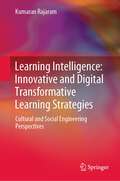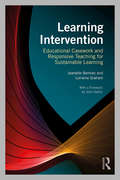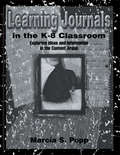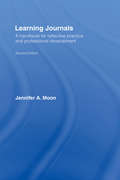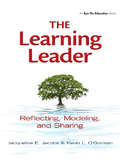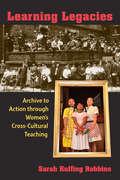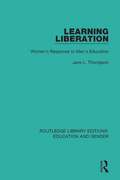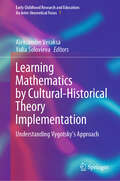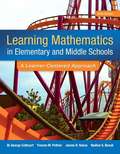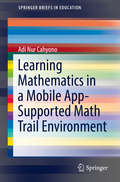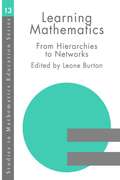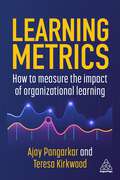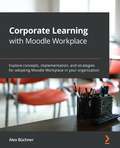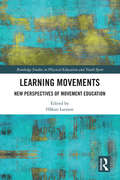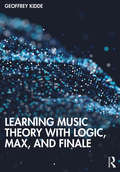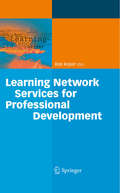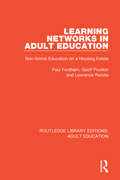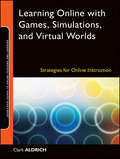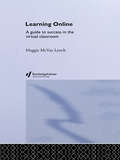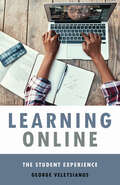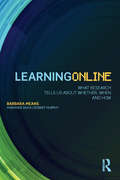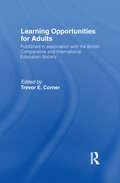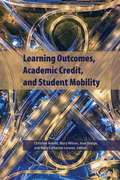- Table View
- List View
Learning Intelligence: Cultural and Social Engineering Perspectives
by Kumaran RajaramThis book provides holistic guidance and proposes practical frameworks to navigate complex learning environments in the rapidly evolving climate, and an environment to facilitate effective learning and knowledge transfer, while advocating a shift in the learning culture, and culture of learning, in varying contexts. It serves well for varying and cross-disciplinary clusters of individuals, particularly for academics, senior management of higher education institutions, and senior leaders of corporate organizations. This book equips readers with a deeper understanding of the evolving and dynamic issues that need to be addressed in the higher education context; to handle multifaceted situations in the process of engaging University students to be nurtured as future global leaders and knowledge workers.
Learning Intervention: Educational Casework and Responsive Teaching for Sustainable Learning
by Lorraine Graham Jeanette BermanThis book explores what learning intervention means in inclusive classroom settings. It provides educational professionals with the knowledge and skills they require to reflect on, and respond to students’ individual learning needs, and enables them to choose, implement and evaluate evidence-based strategies for learning intervention. Taking an ecological perspective, and placing a capability framework at its core, the book considers how responsive teaching and educational casework combine to create intricate layers of learning intervention, and recommends tailored teaching and support strategies that can be used to address a wide variety of student learning needs. Learning intervention is thus understood in its broadest sense, and educational professionals are equipped with a range of interactive and adaptive strategies to support student learning. Chapters introduce and unpack numerous frameworks for practice, provide an extension to Response to Intervention models, and bring together key evidence-based ideas in an accessible format. Effective teaching in response to clearly defined learning needs is central to the achievement of all students. Learning Intervention will provide future and current educational professionals with the structures, knowledge, insight and skills they need to respond effectively to each and every student.
Learning Journals in the K-8 Classroom: Exploring Ideas and information in the Content Areas
by Marcia S. PoppLearning Journals in the K-8 Classroom is the first comprehensive presentation of how to use academic journals effectively for elementary-level instruction. The text outlines the theoretical foundations for using learning journals and provides step-by-step suggestions for implementing them in every content area and at all levels of elementary instruction. Learning journals provide resources and support for reading aloud, independent reading, mini-lessons, cooperative study, individual research, workshops, and the portfolio system. The type of interactive writing students do in learning journals helps them explore complex ideas in the content areas, using their own strengths of analysis and response; the journals then become resources for future learning, group discussions, individual conferences, learning assessment, reports, and progress. Four introductory chapters show teachers how to create their own journals, introduce journals to students, integrate them with cooperative study, and use them for assessment. Additional chapters focus on the individual curriculum areas of literature, writing, mathematics, science, and social studies. The text includes sample entries from student journals at all grade levels and in every content area, and appendices of annotated resources to support journaling and interviews with teachers who use journals in their classrooms.
Learning Journals: A Handbook for Reflective Practice and Professional Development
by Jennifer A. MoonFully updated with important new theory and practical material, this second edition of Learning Journals offers guidance on keeping and using journals and gives step-by-step advice on integrating journal writing on taught courses, in training and professional development and in supporting personal development planning (PDP) activities. Key topics covered include: the nature of learning journals and how we learn from them the broad range of uses of learning journals, including portfolios and personal and professional development the depth and quality of reflection in learning journals the assessment of learning journals and reflective writing the use of narrative and story-telling techniques in journals. With useful exercises and activities that enhance learning journal work in a structured manner, Learning Journals is invaluable reading for teachers and students in higher education, for all professionals, particularly those working in the health services and business and training and for all those who want to learn more about keeping a fulfilling personal journal.
Learning Leader, The: Reflecting, Modeling, and Sharing
by Kevin O'Gorman Jacqueline JacobsWith this book, principals, principals-in-training, and other school leaders get practical, easy-to-implement strategies for professional growth, strengthening relationships with faculty and staff, and making the necessary changes to improve K-12 learning environments. Grounded in specific, real-world examples and personal experiences, The Learning Leader shows educators how to develop both as professional leaders and as learners. Contents include... Using data to improve student learning Advice for applying twenty-first century learning Tips for strengthening communication and collaboration Self-reflection activities to hone leadership goals and skills
Learning Legacies: Archive to Action through Women's Cross-Cultural Teaching
by Sarah Ruffing RobbinsLearning Legacies explores the history of cross-cultural teaching approaches, to highlight how women writer-educators used stories about their collaborations to promote community-building. Robbins demonstrates how educators used stories that resisted dominant conventions and expectations about learners to navigate cultural differences. Using case studies of educational initiatives on behalf of African American women, Native American children, and the urban poor, Learning Legacies promotes the importance of knowledge grounded in the histories and cultures of the many racial and ethnic groups that have always comprised America’s populace, underscoring the value of rich cultural knowledge in pedagogy by illustrating how creative teachers still draw on these learning legacies today.
Learning Liberation: Women's Response to Men's Education (Routledge Library Editions: Education and Gender)
by Jane ThompsonOriginally published in 1983, this book not only dissects the intrinsic and oppressive sexism of conventional adult and continuing education, but also argues the case for women-centred education with a powerful and compelling logic. A challenging and controversial book of the time, mixing provocative theories with details of practice in a wide-ranging and readable debate, it addresses the process through which women’s rights to educational equality can be guaranteed. "Arguably the first feminist analysis of adult education" Daniel Schugurensky
Learning Like a Girl: Educating Our Daughters in Schools of Their Own
by Diana MeehanFaced with a spirited eleven-year-old daughter, a concern about what therapists have called a 'poisonous' youth culture- especially for girls-and a conviction that parents need powerful tools to help their daughters realize their potential, educator-activist DianaMeehan was disappointed in the selection of schools available. So she decided along with two other mothers to create one, based on social science and brain research on how girls learn best. The result, The Archer School in L. A. , has in only ten years become a model for girls' schools nationwide. In this entertaining, inspiring book, Meehan describes her obstacle-ridden journey to create a new institution to serve girls first and foremost, while laying out through vivid stories and examples what girls need to thrive. She explains why co-education so often doesn't serve them (just as it doesn't serve boys), takes sides in the controversy over male/female learning differences, and advocates for schools' role in giving girls tools to navigate through our sexualized, materialistic culture. She also visits other schools around the country-private and public-to show how single sex education works, and how every girl everywhere can benefit from having a classroom of her own.
Learning Mathematics by Cultural-Historical Theory Implementation: Understanding Vygotsky’s Approach (Early Childhood Research and Education: An Inter-theoretical Focus #7)
by Aleksander Veraksa Yulia SolovievaThis book is devoted to the topic of mathematical skills development, which was the focus of Vygotsky's cultural-historical theory. It offers descriptions of studies of development of visual modelling in children and its use for educational purposes. Special attention is given to concrete examples of Vygotsky’s work and educational programs that makes it possible to replicate the results in various settings. The work also addresses conditions, means and predictors of mathematical concepts acquisition at different ages and educational levels (preschool, primary and middle secondary education). The book shows theoretical solidity of cultural-historical approach and experience of its implementation in teaching of mathematical knowledge in childhood and the study of the process of psychological development.
Learning Mathematics in Elementary and Middle School: A Learner-Centered Approach
by George S. Cathcart Yvonne M. Pothier James H. Vance Nadine S. BezukThis popular text promotes a learner-centered approach to teaching elementary and middle school mathematics. It provides valuable research-based instructional strategies, resources, and activities to help teachers evaluate how children think mathematically and how to link that knowledge to developmentally appropriate teaching practice. With its strong focus on Common Core Standards and analyzing children’s work to meet the individual needs of students, the book helps ensure that all students and teachers can be successful with math. The new edition features integration of the Common Core State Standards throughout, new examples of children’s work, updated internet links, expanded videos of children and classrooms, expanded “In Practice” features, and updated research on mathematics teaching and learning.
Learning Mathematics in a Mobile App-Supported Math Trail Environment (SpringerBriefs in Education)
by Adi Nur CahyonoThis brief presents the results of a study on the development of the mobile app-supported math trail program for learning mathematics. This study is a part of the MathCityMap-Project, a project of the MATIS I Team from IDMI Goethe-Universität Frankfurt, Germany, that comprises math trails around the city that are supported by the use of GPS-enabled mobile phone technology. The project offers an activity that is designed to support students in constructing their own mathematical knowledge by solving the prepared mathematical tasks on the math trail and interacting with the environment, including the digital environment. The brief focuses specifically on the development of a model for a mobile app-supported math trail programme and the implementation of this programme in Indonesia. It offers both an empirical exploration of its implementation as well as critical assessment of students’ motivation in mathematics, their own performance, as well as teachers’ mathematics beliefs. It concludes with a future-forward perspective by recommending strategies for implementation in schools, among the general public of the existing math trails (including its supporting tool). It also discusses strategies for developing and designing new trails and suggests further research in other geographical regions and contexts for continued project development and implementation. Learning Mathematics in a Mobile App-Supported Math Trail Environment articulates an innovative and exciting future for integrating real mathematical tasks and geographic and digital environment into effective mathematics education.
Learning Mathematics: From Hierarchies to Networks (Studies In Mathematics Education Ser. #Vol. 34)
by Leone BurtonLearning Mathematics brings together a collection of interrelated and forward-looking chapters by internationally recognized experts that explores changes in the theories and practices of learning (and teaching) mathematics.The authors reject a traditional, transmission view of the teaching of mathematics which has proved so ineffective for learning. In its place they offer information gathered from research and from practice about effects on the learners seeking to create and negotiate meaning. Learners are presented as actively attempting to make sense of the mathematics they encounter, and learners, teachers and researchers are offered examples of ho such sense-making activities, incorporated into mathematics classrooms, impact on coming to know.The book celebrates both diversity, in the range of different perspectives, contributions and topics, and unity, in the linking chapters and themes, It will be fascinating reading for those mathematics educators who are eager to engage with a socio-cultural perspective in order to better understand the complexity of learning mathematics.
Learning Media Assessment of Students With Visual Impairments: A Resource Guide for Teachers (Second Edition)
by Alan J. Koenig M. Cay HolbrookThe book guides the educators to identify the best possible reading format for a student - either through braille, objects, audio or combinations of these. This is an essential early step before undertaking the actual literacy education.
Learning Metrics: How to Measure the Impact of Organizational Learning
by Ajay Pangarkar Teresa KirkwoodHow do I know if Learning and Development (L&D) initiatives are making a difference to employee and business performance? What should I measure and how do I take a data-driven approach?Learning Metrics is a practical book for L&D professionals which answers these questions and provides guidance for measuring and communicating the impact of L&D activity in the business. It covers how to measure participant engagement with learning, learning retention and changes in employee performance post-learning. There is also guidance on how to measure on-the-job behaviour change as a result of learning, as well as metrics for measuring the organizational impact of learning. This book also has essential guidance on how to use learning analytics to assess the return on investment (ROI) of learning and how to use these results to adopt a data-driven approach and map learning metrics to organizational KPIs. Learning Metrics also includes guidance on how to communicate the impact of the company's learning and development activity to all business stakeholders. Full of practical guidance, examples, advice and case studies from organizations including Pfizer, Goldman Sachs, HSBC, Merck and Hewlett Packard, this is essential reading for all L&D professionals needing to measure the impact of L&D activity in the business but not sure where to start.
Learning Moodle Workplace
by Alex BüchnerThis book is for workplace administrators in technical, organizational as well as pedagogical capacity. Managers who lead teams in the workplace, especially HR, will also find it useful. Learners who use Workplace for their continuous professional development will also benefit from the book. Prior exposure to the Moodle platform will help you follow the book easily.
Learning Movements: New Perspectives of Movement Education (Routledge Studies in Physical Education and Youth Sport)
by Håkan LarssonContemporary ways of understanding human movements, specifically movement learning, are heavily dominated by individualistic, dualistic and mechanistic perspectives. These perspectives are individualistic in the sense that in research as well as in educational practice movements/movers are typically decontextualized, they are dualistic in the sense that the body is taken to be ‘inhabited’, even ‘governed,’ by a rational mind which is not itself a part of that body; and they are mechanistic in the sense that movements and movement learning can be ‘calculated’. This approach has supported the dominance of a westernised and predominantly white, masculinised and heteronormative view of able bodies, embodiment and movements. Hence, it has contributed to marginalise not only other approaches and perspectives and individuals. New research has evolved, including new approaches and these held perspectives have been challenged by social and culturally sensitive, holistic as well as pluralistic, and dynamic/organic perspectives of human movements and moving humans. Examples of such research can be found in disciplines such as; physical education and pedagogy, ethnography, philosophy, and sociology. Learning Movements: New Perspectives of Movement Education provides the societal and epistemological background for these new approaches and will be essential in disseminating this knowledge to movement educators, academics and researchers as well as professionals within education, sports, health and fitness, dance, outdoor activities, etc., and that it will spearhead new and inclusive practices within these settings.
Learning Music Theory with Logic, Max, and Finale
by Geoffrey KiddeLearning Music Theory with Logic, Max, and Finale is a groundbreaking resource that bridges the gap between music theory teaching and the world of music software programs. Focusing on three key programs—the Digital Audio Workstation (DAW) Logic, the Audio Programming Language (APL) Max, and the music-printing program Finale—this book shows how they can be used together to learn music theory. It provides an introduction to core music theory concepts and shows how to develop programming skills alongside music theory skills. Software tools form an essential part of the modern musical environment; laptop musicians today can harness incredibly powerful tools to create, record, and manipulate sounds. Yet these programs on their own don’t provide musicians with an understanding of music notation and structures, while traditional music theory teaching doesn’t fully engage with technological capabilities. With clear and practical applications, this book demonstrates how to use DAWs, APLs, and music-printing programs to create interactive resources for learning the mechanics behind how music works. Offering an innovative approach to the learning and teaching of music theory in the context of diverse musical genres, this volume provides game-changing ideas for educators, practicing musicians, and students of music. The author's website at http://www.geoffreykidde.com includes downloadable apps that support this book.
Learning Network Services for Professional Development
by Rob KoperA "Learning Network" is a community of people who help each other to better understand and handle certain events and concepts in work or life. As a result - and sometimes also as an aim - participating in learning networks stimulates personal development, a better understanding of concepts and events, career development, and employability. "Learning Network Services" are Web services that are designed to facilitate the creation of distributed Learning Networks and to support the participants with various functions for knowledge exchange, social interaction, assessment and competence development in an effective way. The book presents state-of-the-art insights into the field of Learning Networks and Web-based services which can facilitate all kinds of processes within these networks.
Learning Networks in Adult Education: Non-formal Education on a Housing Estate (Routledge Library Editions: Adult Education)
by Paul Fordham Geoff Poulton Lawrence RandleOriginally published in 1979, this book reports on a 3 year action research programme (The New Communities Project) which aimed in increase working-class participation in adult education. Basing their argument on the work of the Project, the authors contend that adult education must begin with the people themselves, to go on and assist their intellectual, social, psychological, cultural and political growth. In their view, adult education needs to be identified as something more flexible than 'classes', whilst also distinguishing between non-formal education and other kinds of community work or development. Providing different perspectives on the way in which a service relates to a particular area, the book's conclusions have a bearing on both practice and training in a variety of areas concerned with social intervention.
Learning Online with Games, Simulations, and Virtual Worlds
by Clark AldrichHigher education institutions are increasingly delivering content online, but the content is often not sufficiently engaging. Learning Online with Games, Simulations, and Virtual Worlds provides a simple and practical guide to identifying when and what kind of games, simulations, and virtual environments should be used, how to get them, how to deploy them, and how to measure their effectiveness. Using frameworks, tips, case studies, real examples, and resources, this cutting-edge tool will help faculty members and instructional designers comfortably use games, simulations, and virtual environments to enhance learning.
Learning Online: A Guide to Success in the Virtual Classroom
by Maggie McVay LynchWhether taking classes in school, college or university, or in a corporate training setting, it is likely that learners will be expected to do at least part of their studies via the computer. This book provides realistic guidelines to ensure their success in the virtual learning environment. From detailing tools such as WebCT and Blackboard, to overcoming personal barriers to success in distance learning, this handy text deals with issues that readers of any age, stage or situation are likely to encounter by: * demystifying terms and concepts common to online learning* addressing issues of online ethics such as netiquette, plagiarism and software piracy* offering practical advice on interacting effectively online, submitting assignments and doing research* furnishing numerous links to Web pages and other resources for further study and research. The author offers serious and humorous anecdotes to help readers avoid the pitfalls and capitalize on opportunities that will help them become a successful online student. Current and prospective online learners will greatly benefit from this practical book filled with clear, detailed assistance for learning online.
Learning Online: The Student Experience (Tech.edu: A Hopkins Series on Education and Technology)
by George VeletsianosWhat's it really like to learn online?Learning Online: The Student ExperienceOnline learning is ubiquitous for millions of students worldwide, yet our understanding of student experiences in online learning settings is limited. The geographic distance that separates faculty from students in an online environment is its signature feature, but it is also one that risks widening the gulf between teachers and learners. In Learning Online, George Veletsianos argues that in order to critique, understand, and improve online learning, we must examine it through the lens of student experience.Approaching the topic with stories that elicit empathy, compassion, and care, Veletsianos relays the diverse day-to-day experiences of online learners. Each in-depth chapter follows a single learner's experience while focusing on an important or noteworthy aspect of online learning, tackling everything from demographics, attrition, motivation, and loneliness to cheating, openness, flexibility, social media, and digital divides. Veletsianos also draws on these case studies to offer recommendations for the future and lessons learned. The elusive nature of online learners' experiences, the book reveals, is a problem because it prevents us from doing better: from designing more effective online courses, from making evidence-informed decisions about online education, and from coming to our work with the full sense of empathy that our students deserve. Writing in an evocative, accessible, and concise manner, Veletsianos concretely demonstrates why it is so important to pay closer attention to the stories of students—who may have instructive and insightful ideas about the future of education.
Learning Online: What Research Tells Us About Whether, When and How
by Robert Murphy Barbara Means Marianne BakiaAt a time when more and more of what people learn both in formal courses and in everyday life is mediated by technology, Learning Online provides a much-needed guide to different forms and applications of online learning. This book describes how online learning is being used in both K-12 and higher education settings as well as in learning outside of school. Particular online learning technologies, such as MOOCs (massive open online courses), multi-player games, learning analytics, and adaptive online practice environments, are described in terms of design principles, implementation, and contexts of use. Learning Online synthesizes research findings on the effectiveness of different types of online learning, but a major message of the book is that student outcomes arise from the joint influence of implementation, context, and learner characteristics interacting with technology--not from technology alone. The book describes available research about how best to implement different forms of online learning for specific kinds of students, subject areas, and contexts. Building on available evidence regarding practices that make online and blended learning more effective in different contexts, Learning Online draws implications for institutional and state policies that would promote judicious uses of online learning and effective implementation models. This in-depth research work concludes with a call for an online learning implementation research agenda, combining education institutions and research partners in a collaborative effort to generate and share evidence on effective practices.
Learning Opportunities for Adults
by Trevor E. CornerArgues for the financial backing from governments and industry for adult education and will help adult and community educators draw comparisons between their own work and that of their colleagues in other developed countries.
Learning Outcomes, Academic Credit and Student Mobility (Queen's Policy Studies Series #201)
by Christine Arnold, Mary Wilson, Jean Bridge, and Mary Catharine LennonThere is increasing interest in the use of learning outcomes in postsecondary education, and deliberations have surfaced with regard to their potential to serve as a tool for advancing credit transfer. Learning Outcomes, Academic Credit, and Student Mobility assesses the conceptual foundations, assumptions, and implications of using learning outcomes for the purposes of postsecondary credit transfer and student mobility. Through a critical review of current approaches to the use of learning outcomes across national and international jurisdictions, scholars and practitioners in postsecondary education provide a multivalent examination of their potential impacts in the unique context of Ontario and recommend future directions for the system. The collected works are the culmination of a multi-year study entitled Learning Outcomes for Transfer, funded by the Ontario Council on Articulation and Transfer. Contributions are authored by prominent international scholars across countries with significant outcomes-based experience and education reforms (South Africa, the United States, Australia, Europe, and the United Kingdom) and an Ontario research consortium comprising college and university experts working to advance student pathways.
